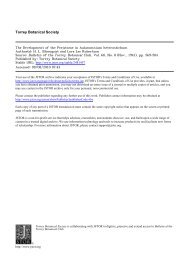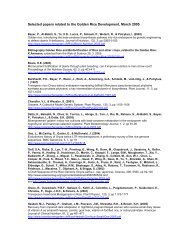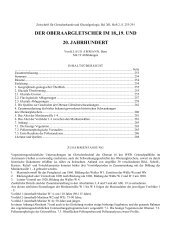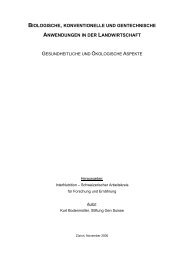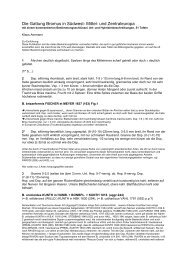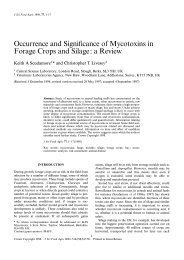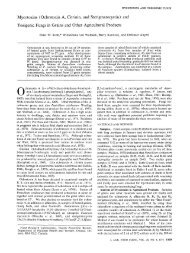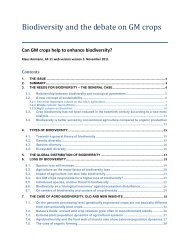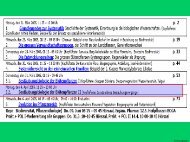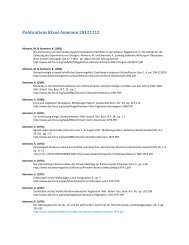Genetic engineering of plants to enhance resistance to fungal ...
Genetic engineering of plants to enhance resistance to fungal ...
Genetic engineering of plants to enhance resistance to fungal ...
You also want an ePaper? Increase the reach of your titles
YUMPU automatically turns print PDFs into web optimized ePapers that Google loves.
Punja: genetic <strong>engineering</strong> / <strong>fungal</strong> disease <strong>resistance</strong> 225<br />
cretion <strong>of</strong> a range <strong>of</strong> plant cell wall degrading enzymes<br />
(depolymerases) and the production <strong>of</strong> <strong>to</strong>xins such as oxalic<br />
acid by <strong>fungal</strong> pathogens. Several strategies <strong>to</strong> engineer <strong>resistance</strong><br />
against <strong>fungal</strong> infection have targeted the inactivation <strong>of</strong><br />
these pathogen virulence products. Polygalacturonaseinhibiting<br />
proteins (PGIP) are glycoproteins present in the cell<br />
wall <strong>of</strong> many <strong>plants</strong> and that can inhibit the activity <strong>of</strong> <strong>fungal</strong><br />
endopolygalacturonases (Powell et al. 1994; Desiderio et al.<br />
1997). The expression <strong>of</strong> PGIP in transgenic <strong>plants</strong> led <strong>to</strong><br />
contrasting results: in transgenic <strong>to</strong>ma<strong>to</strong> expressing a bean<br />
PGIP, <strong>resistance</strong> <strong>to</strong> Fusarium, Botrytis, orAlternaria was<br />
not <strong>enhance</strong>d (Desiderio et al. 1997) while in transgenic <strong>to</strong>ma<strong>to</strong><br />
expressing a pear PGIP, colonization <strong>of</strong> leaves and<br />
fruits by Botrytis was reduced (Powell et al. 2000). In the<br />
former study, it was shown that PGIPs from bean differed<br />
in specificity <strong>to</strong> <strong>fungal</strong> polygalacturonase in vitro, and the<br />
PGIP-1 that had been selected for transformation was not<br />
inhibi<strong>to</strong>ry (Desiderio et al. 1997). Thus, appropriate in vitro<br />
screening <strong>of</strong> PGIPs would be required prior <strong>to</strong> undertaking<br />
transformation experiments. As with the PR proteins and<br />
anti<strong>fungal</strong> compounds, disease development was reduced by<br />
PGIPs but not <strong>to</strong>tally prevented in the transgenic <strong>plants</strong>.<br />
Another developed strategy that could have potential <strong>to</strong><br />
reduce pathogen infection is immunomodulation, the expression<br />
<strong>of</strong> genes encoding antibodies or antibody fragments<br />
in <strong>plants</strong> (plantibodies) that could bind <strong>to</strong> pathogen<br />
virulence products (De Jaeger et al. 2000; Schillberg et al.<br />
2001). The antibodies can be expressed inter- or extracellularly<br />
and can bind <strong>to</strong> and inactivate enzymes, <strong>to</strong>xins, or<br />
other pathogen fac<strong>to</strong>rs involved in disease development.<br />
Currently, there are no published reports on the expression<br />
<strong>of</strong> anti<strong>fungal</strong> antibodies in transgenic <strong>plants</strong> that have led <strong>to</strong><br />
a reduction in disease. However, it has been demonstrated<br />
that antilipase antibodies inhibited infection <strong>of</strong> <strong>to</strong>ma<strong>to</strong> by<br />
Botrytis cinerea, when mixed with spore inoculum, by preventing<br />
<strong>fungal</strong> penetration through the cuticle (Comménil et<br />
al. 1998). Similarly, infection by Colle<strong>to</strong>trichum gloeosporioides<br />
on various fruits was inhibited using polyclonal<br />
antibodies that bound <strong>to</strong> <strong>fungal</strong> pectate lyase (Wattad et al.<br />
1997). <strong>Genetic</strong> <strong>engineering</strong> <strong>of</strong> antibody expression in <strong>plants</strong><br />
is extremely challenging technically and the applications <strong>to</strong><br />
<strong>fungal</strong> disease control (immunization) have yet <strong>to</strong> be determined,<br />
although success against virus diseases has been reported<br />
(De Jaeger et al. 2000).<br />
Production <strong>of</strong> phy<strong>to</strong><strong>to</strong>xic metabolites, such as myco<strong>to</strong>xins<br />
and oxalic acid, by <strong>fungal</strong> pathogens has been shown <strong>to</strong> facilitate<br />
infection <strong>of</strong> host tissues following cell death. Degradation<br />
<strong>of</strong> these compounds by enzymes expressed in<br />
transgenic <strong>plants</strong> could provide an opportunity <strong>to</strong> <strong>enhance</strong><br />
<strong>resistance</strong> <strong>to</strong> disease. Expression <strong>of</strong> a trichothecenedegrading<br />
enzyme from Fusarium sporotrichioides in transgenic<br />
<strong>to</strong>bacco reduced plant tissue damage and <strong>enhance</strong>d<br />
seedling emergence in the presence <strong>of</strong> the trichothecene<br />
(Muhitch et al. 2000). The effect on pathogen development<br />
was not tested. Germin-like oxalate oxidases are stable<br />
glycoproteins first discovered in cereals, which are present<br />
during seed germination and are induced in response <strong>to</strong> <strong>fungal</strong><br />
infection and abiotic stress (Dumas et al. 1995; Zhang et<br />
al. 1995; Berna and Bernier 1997). Their activity on the<br />
substrate oxalic acid results in the production <strong>of</strong> CO 2 and<br />
H 2 O 2 ; the latter can induce defense responses in the plant<br />
and <strong>enhance</strong> strengthening <strong>of</strong> cell walls (Brisson et al.<br />
1994; Mehdy 1994). The expression <strong>of</strong> barley oxalate<br />
oxidase in oilseed rape <strong>enhance</strong>d <strong>to</strong>lerance <strong>to</strong> the phy<strong>to</strong><strong>to</strong>xic<br />
effects <strong>of</strong> oxalic acid, although the effect on the target<br />
pathogen Sclerotinia sclerotiorum was not evaluated<br />
(Thompson et al. 1995). Expression <strong>of</strong> oxalate oxidase in<br />
transgenic hybrid poplar <strong>enhance</strong>d <strong>resistance</strong> <strong>to</strong> Sep<strong>to</strong>ria,<br />
while oxalate decarboxylase expression <strong>enhance</strong>d <strong>resistance</strong><br />
<strong>of</strong> <strong>to</strong>ma<strong>to</strong> <strong>to</strong> Sclerotinia sclerotiorum (Table 1). These reports<br />
indicate that the inactivation <strong>of</strong> specific pathogen virulence<br />
fac<strong>to</strong>rs, such as <strong>to</strong>xins, by gene products expressed<br />
in transgenic <strong>plants</strong> has the potential <strong>to</strong> reduce development<br />
<strong>of</strong> specific <strong>fungal</strong> pathogens.<br />
Alteration <strong>of</strong> structural components<br />
Lignification <strong>of</strong> plant cells around sites <strong>of</strong> infection or lesions<br />
has been reported <strong>to</strong> be a defense response <strong>of</strong> <strong>plants</strong><br />
that can potentially slow down pathogen spread (Nicholson<br />
and Hammerschmidt 1992). The enzyme peroxidase is required<br />
for the final polymerization <strong>of</strong> phenolic derivatives<br />
in<strong>to</strong> lignin and may also be involved in suberization or<br />
wound healing. A decrease in polyphenolic compounds,<br />
such as lignin, in pota<strong>to</strong> tubers by redirection <strong>of</strong> tryp<strong>to</strong>phan<br />
in transgenic <strong>plants</strong> through expression <strong>of</strong> tryp<strong>to</strong>phan decarboxylase<br />
rendered tissues more susceptible <strong>to</strong> Phy<strong>to</strong>phthora<br />
infestans (Yao et al. 1995), illustrating the role <strong>of</strong> phenolic<br />
compounds in defense. Reduction <strong>of</strong> phenylpropanoid metabolism<br />
through inhibition <strong>of</strong> phenylalanine ammonialyase<br />
activity in transgenic <strong>to</strong>bacco also rendered tissues<br />
more susceptible <strong>to</strong> Cercospora nicotianae (Maher et al.<br />
1994). Overexpression <strong>of</strong> a cucumber peroxidase gene in<br />
transgenic pota<strong>to</strong>, however, did not increase <strong>resistance</strong> <strong>of</strong><br />
tissues <strong>to</strong> infection by Fusarium or Phy<strong>to</strong>phthora, and<br />
lignin levels were not significantly affected, in spite <strong>of</strong> elevated<br />
peroxidase expression (Ray et al. 1998). It was suggested<br />
that peroxidase levels may not have been the limiting<br />
step for lignification or that the native peroxidase activity<br />
may have been cosuppressed. Overexpression <strong>of</strong> a <strong>to</strong>bacco<br />
anionic peroxidase gene in <strong>to</strong>ma<strong>to</strong> did <strong>enhance</strong> lignin levels<br />
but <strong>resistance</strong> <strong>to</strong> <strong>fungal</strong> pathogens was not <strong>enhance</strong>d<br />
(Lagrimini et al. 1993). Lignin levels were also significantly<br />
higher following expression <strong>of</strong> the H 2 O 2 -generating enzyme<br />
glucose oxidase in transgenic pota<strong>to</strong> (Wu et al. 1997) and<br />
by expression <strong>of</strong> the hormone indoleacetic acid (IAA) in<br />
transgenic <strong>to</strong>bacco (Sitbon et al. 1999). In the former case,<br />
<strong>to</strong>lerance <strong>to</strong> several <strong>fungal</strong> pathogens was <strong>enhance</strong>d (Table<br />
1). Peroxidase overexpression in <strong>plants</strong> can, however,<br />
have negative effects on plant growth and development<br />
(Lagrimini et al. 1997), and the results <strong>to</strong> date indicate that<br />
this approach appears <strong>to</strong> hold less promise for enhancing<br />
disease <strong>resistance</strong>.<br />
A reduction in large callose deposits surrounding<br />
haus<strong>to</strong>ria <strong>of</strong> Peronospora parasitica infecting Arabidopsis<br />
thaliana was indirectly achieved in transgenic <strong>plants</strong> not accumulating<br />
SA by expression <strong>of</strong> the enzyme salicylate hydroxylase<br />
(Don<strong>of</strong>rio and Delaney 2001). These <strong>plants</strong> also<br />
had reduced expression <strong>of</strong> the PR-1 gene and exhibited significantly<br />
<strong>enhance</strong>d susceptibility <strong>to</strong> the pathogen, suggesting<br />
that callose deposition during normal defense responses<br />
<strong>of</strong> the plant was influenced by the reduced levels <strong>of</strong> SA.



